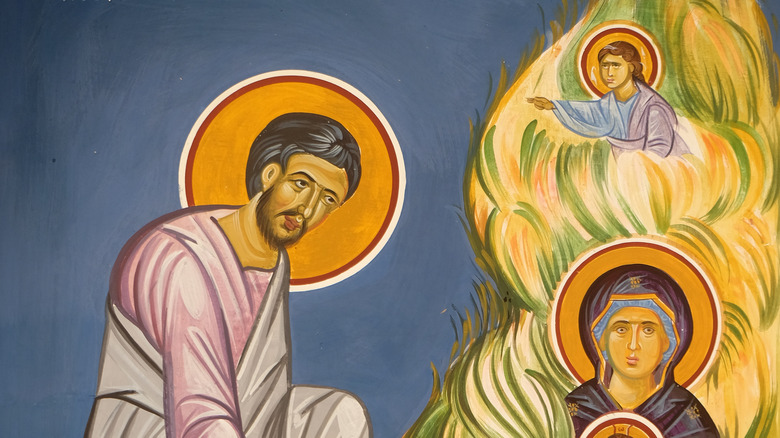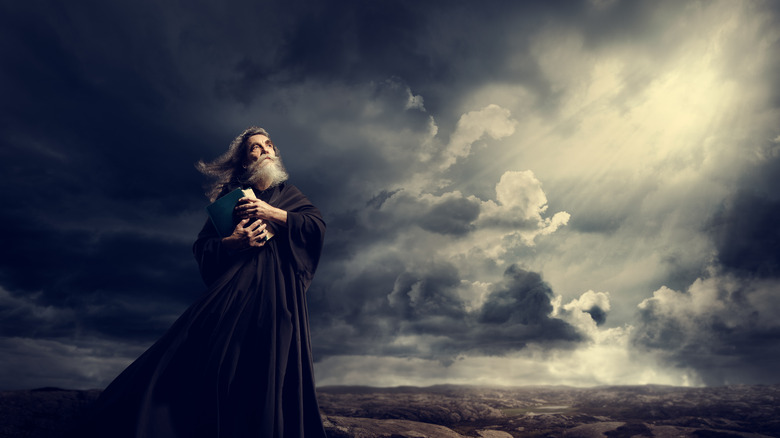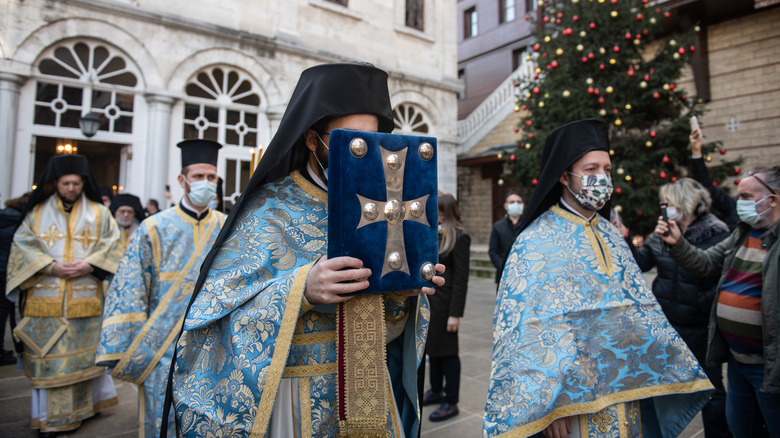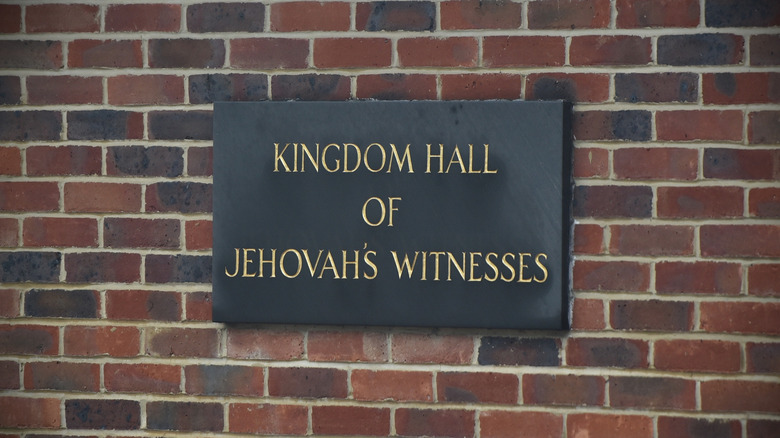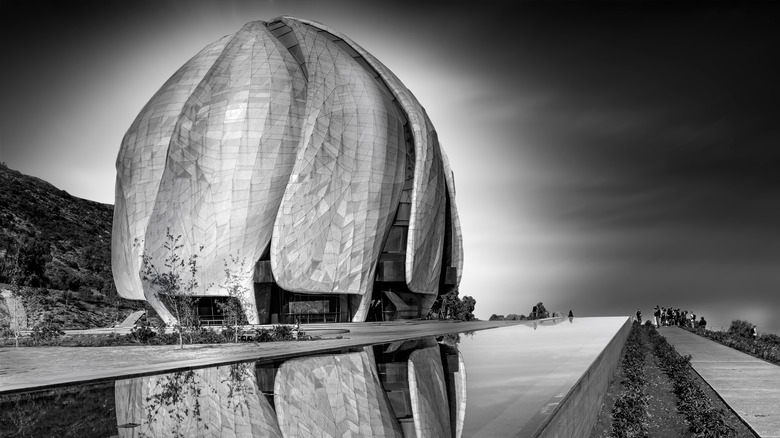The Bible's Burning Bush Explained
The most ubiquitous version of the story of the burning bush is found in chapter three of the Book of Exodus within the Christian Bible. In the story, Moses sees a bush that is engulfed in flames, yet does not disintegrate. Its form remains. Moses goes to get a closer look, and the "the God of Abraham, the God of Isaac and the God of Jacob" speaks to him from the burning bush. On this mountain (foreshadowing another moment in his life), Moses becomes the next in line of imperfect people called by God to do remarkable and redemptive acts in God's name (via Exodus 3 NIV).
No one is sure about what type of tree or bush was aflame but not consumed. However, the Jewish Encyclopedia speaks to the central drive of the story and why this tree or bush was selected by the Hebrew God. "It was ... a living thing, the only object ... that had life in it; and it belonged, moreover, to a class of objects often made the abode of divinity." This miracle, by most standards, would come to be seen as a symbol of faith, divine revelation, and redemption within the three main monotheistic religions. However, what does it actually mean and how do people interpret it?
Theophany
Spiritual beings revealing themselves to humanity is present in some form or fashion in the myths, legends, and/or doctrines of religious faith in every culture within every country. The idea of "theophany" is the self-revelation of the divine to humankind. The events of the burning bush are first and foremost another example of the Hebrew God revealing himself to his people. According to the Encyclopaedia Biblica, "The story in the form which it assumes in Exodus appears to have resulted from a fusion of two widely current beliefs that fire indicated the divine presence, and that certain trees were the permanent abodes of deities."
The presence of a theophany can be deeply perilous to humanity simply because according to religious beliefs, humans are merely creatures made by god or gods, and to be in the presence of a being so holy is to be overpowering. In the fourth volume of the Encyclopaedia Biblica, it states of the general nature of human encounters with revelations from the Divine that "many narratives ... record cases in which men saw God, or at least perceived through the senses that he was present, and yet lived."
Etymology and Location
Translating Hebrew, even for the most well-versed, can be tricky, and it is often very easy to mistranslate or, at the very least, not find an easy one-to-one correlation between Hebrew and English. "The word rendered 'bush' is found only in this passage [of Exodus] and in Deut. xxxiii. 16, where, however, it is possible that the right reading is 'Sinai'" (via Jewish Encyclopedia). Considering who is involved in this moment of theophany, this critical rendering of the term found in two places within the Torah (or Old Testament) seems not only plausible, but highly likely. Moses would iconically go up Mt. Sinai and bring down to the Hebrews the Ten Commandments. Yet most readers and commentators have taken this to read as a bramble or thorn bush for various insightful and metaphorical reasons (via The Legends of the Jews).
It is not clear to this day where exactly the location of the burning bush — or perhaps Sinai, if one takes that interpretation — is, but one potential place is St. Catherine's monastery in what is now modern-day Egypt. Named after a martyred Egyptian saint, it is said that this monastery was built on the location of the burning bush and has a bush growing still within its premises (via Popa's Tales). It is hard enough to "prove" the existence of such events, but to pinpoint their location within modern-day nation-states with boundaries that have shifted over history is a whole other feat.
Moses Before the Burning Bush
According to Herbert Lockyer's "All the Men of the Bible," Moses was low-born at a time when the Pharaoh ordered all male Israelite babies to be killed, so his mother sent him down a river to save him and he was discovered and raised by the daughter of the Pharaoh. Yet being part of the Pharaoh's family meant that he came into contact with his own people who were the slaves of the Egyptians. "But the more they were oppressed, the more they multiplied and spread; so the Egyptians came to dread the Israelites and worked them ruthlessly" (via Exodus 1:12 NIV). Moses, when he was older, saw an Egyptian beat one of his people, and he killed the Egyptian and fled from the Pharaoh who tried to have him killed (via Exodus 2:11-12 NIV).
He found his way to the land of Midian, where he lived with and married a shepherd's daughter by the name of Zipporah. However, neither the cries of his people — the enslaved Israelites — nor God would leave him be for very long. The veil of his perceived existence was about to come down when he drove his sheep out to Horeb one last time (via New Advent).
Moses after the Burning Bush
After Moses' encounter with God at the burning bush, his whole world is upended. As an escaped murderer, he is called to go back to the land of his crime and death warrant and free his people from the Pharaoh, the man who allowed him to be raised in his courts. The brilliance of this story is in how it has Moses go back and do the same thing he tried to do when he murdered the Egyptian — enact justice — but, now, he has the power of God at his side instead of merely his own human will (via Exodus 4:18-31 NIV).
The rest of the story is well known throughout various cultures, including films like Cecil B. DeMille's "The Ten Commandments" and the more recent "Exodus: Gods and Kings" (via Decent Films). Through 10 plagues on Egypt (including the final one that took the firstborn of each Egyptian family), a blockbuster chase through the Red Sea, and the Pharaoh's ultimate defeat, it's quite easy to see how the theophany of the burning bush and God's revelation changed Moses' life.
Jewish Interpretations
Exodus is perhaps the most important book within the Torah, because it shows the endurance and extremes of God's faithfulness to his people — literally freeing them from slavery so that they can be God's people. According to the Jewish Theological Seminary of America, "Moses already senses that freedom from Egypt is not simply about personal liberation. Rather, the endeavor speaks to a larger, national mission of serving God." As a collective, ethnic people, the Hebrews not only recognize their individual release from slavery, but they begin to form as a nation that is bound in worship of and service to the God who freed them.
The Jewish Encyclopedia goes even farther with the imagery of the burning bush, "The burning but not consuming fire of the bush indicated to Moses that Israel would successfully endure all the sorrows and pains inflicted upon it by the Egyptians." The imagery of the fire that burns but does not disintegrate the bush is a symbol for the Jewish people that, much like their slavery in Egypt, whatever suffering they might endure, they will come forth from it by the hand of their God, YHWH. It is not difficult to see the truth of this symbolism as one looks at the Jewish people throughout history.
Protestant Christian Interpretations
In his commentary on Exodus, John Calvin, a Protestant Reformer, writes, "The bush is likened to the humble and despised people; their tyrannical oppression is not unlike the fire which would have consumed them, had not God miraculously interposed. ... that though the waves of trouble beat against the Church and threaten her destruction, yet 'shall she not be moved,' for 'God is in the midst of her.'" There is a common tie between the Protestant Christian rendering of this event and the Jewish one: God sees his people being oppressed and delivers them from their troubles. As long as they are God's people, they will not be consumed.
Where the Christian and Jewish interpretations diverge is in who is included within the "people of God." Unlike the Jewish interpretations, the Christian view of the inhabitants of God's "national mission" involves Jews and Gentiles, a term for non-Jewish persons or nations. As Jane Williams, Anglican (Protestant) theologian and wife to Rowan Williams, previous archbishop of Canterbury, wrote about in 2009 for The Guardian, The Acts of the Apostles (with Luke as historian) essentially spread "the gospel all over the world and through all cultures ... with Peter and Philip ... already [preaching] to non-Jews ..."
Orthodox and Catholic Interpretations
The Orthodox and Catholic churches have various disagreements in doctrine and practices; however, they come to a similar interpretative framework for the burning bush. They have an "Unburnt Bush" icon that shows Mary within the symbolic flames of the bush, which demonstrates that "just as the bush was burning without being consumed, the Virgin gave birth to Christ while remaining a virgin" (via Aleteia). Both zero in on the paradox of something that maintains its prior state in the midst of an event that should rationally change that state. The fire should destroy the bush just as Mary birthing Jesus should have negated her virgin status. Yet, in both cases, their former states are preserved.
The St. Paul Center speaks to the various moments in the Old Testament where the divine theophany appears in fire descending onto humanity. Curtis Mitch goes on to explain, "Now, if Mary's child is a divine Child, and the divine presence is revealed in fire, then it seems beautifully fitting to see the Burning Bush as a figure of her divine maternity." In other words, this theophany of God points to his son, Jesus Christ, and the mystery of Mary's virgin birth in the Gospels. This is one of the reasons why the Catholic and Orthodox churches hold Mary in high esteem, something that the Protestant wing of Christianity denies (via Christianity in View).
Interpretations of Christian Sects
There are various sects and offshoots of the mainstream Protestant Christian religion. Yet, even these various sects have their own bent on the burning bush even though their starting point falls in line with the mainstream Christian church. According to the Christian Science Journal, "The student of the Scriptures can trace this fire of inspiration, this holy light of Truth which illumines human consciousness, in the experiences of patriarch, prophet, and disciple." What should be noticed here is the language being used. Compared to the other Jewish and Christian interpretations, Christian Scientists use a framework that hearkens back to Enlightenment philosophy instead of divine mystery. Enlightenment thinkers embraced reason as a core tenet, notes Britannica, over faith and doctrine.
The Mormons also shift, their language around the burning bush, as Mormon scholar Ellis T. Rasmussen, explains, "A manifestation was given to Moses by a messenger of light, causing a bush to appear to burn; it was really not afire and was not consumed." According to the Mormons, the bush only appeared to be on fire, but was not, in actual fact, on fire, which is why it was not consumed. Instead they focus on the illuminating glory of God, with the bush "herald[ing] a message from God," rather than the miracle of a non-consuming, physical fire.
In these two cases, at least, it does appear that Christian sects attempt to strike a balance between Enlightenment rationality and Christian miracles.
Islamic Interpretation
Islam, too, incorporates their own understanding of the burning bush incident, which varies from both Jewish and Christian interpretations. There are three separate mentions of this story of Moses in the Qur'an, but only one of them mentions the burning bush. According to Sura 28:30, "And when [Musa, or Moses] came to it, a voice was uttered from the right side of the valley in the blessed spot of the bush, saying: O Musa! surely I am Allah, the Lord of the worlds" (via The Spirit of Islam).
The Qur'annic version of the story strips it of the Jewish salvation tale and instead solidifies the common revelation that Allah is the only true God. Yet, in Esra Akin-Kivanc's study on "Mirror Writing in Islamic Calligraphy," "Moses's metaphysical experience [of the burning bush] can be considered ... viewing a muthanna: one's enlightenment is circumscribed by one's level of preparedness and receptivity." In other words, the form a revelation takes is due to the reality of our want or need. Kivanc notes that Musa needed fire for his family, so he saw the revelation of Allah as a bush on fire. The content of the revelation may be completely holy and other, but the form in which the revelation takes, according to Kivanc, is relative to the desire of the witness.
Bahá'í Faith Interpretations
Bahá'í is one of the newer religions that started in the 19th century and teaches "the essential unity of all religions and the unity of humanity, and that the "founders of the world's great religions have been manifestations of God and agents of a progressive divine plan for the education of the human race" (via Encyclopedia Britannica).
One mention of the burning bush comes in a Bahá'í prayer: "The brightness of the fire of your love will no doubt fuse and unify the contending peoples and kindreds of the earth, whilst the fierceness of the flame of enmity and hatred cannot but result in strife and ruin" (via Bahá'í.org). In another text, there is an anarchistic tone to the proceeding of Moses back to Egypt: "the palaces of the potentates shall be laid waste and the imposing buildings of the emperors reduced to dust" (via Bahá'í.org). It seems as if the Bahá'í interpretation seeks to strike a balance between fire as illumination and fire as destruction, never quite siding with one or the other.
Rastafarian Interpretation and Weed Culture
The Rastafarian movement started in the 1930s among the working class Blacks of Jamaica who saw middle class whites as those who stole their African identity away from them when they were brought to the Caribbean as slaves (via The New Times). Haile Selassie I, leader of Ethiopia at one time, is considered their Moses and their God. The movement is by its very design an Afro-centric religion. According to the same New Times article, ganja "signifies the healing of the nations ... and, is used as a holy sacrament by Rastas in many ways. Rastas smoke herb to meditate, symbolizing the burning bush, and for its curative properties i.e. asthma."
In similar fashion, High Times asks the question as to whether Moses was stoned when he saw the burning bush. They state, "In 1936, an etymologist working at the Institute of Anthropology in Warsaw, Sula Benet, noted that the Hebrew words kaneh and kaneh-bosem (cane and fragrant cane) — mistakenly translated as "calamus" in the Old Testament — were in fact a reference to our modern word cannabis." Where Rastafarian belief is much more involved than just weed and deeply invested in African history, it does share some of its interpretative framework with the wider weed culture.
Scientific Interpretation ... or Lack Of
Science has, of course, sought to provide answers to the many events of the Bible (and other religious texts) — that is if they are willing to presume the historical accuracy of the texts in the first place. Plenty of researchers don't pay mind to religious texts and dogmas in order to even entertain explanations of miracles (via Nature). Yet, science doesn't seek to "interpret" events as it does to offer rational, logical explanations.
One such explanation for the burning bush involves the scraping of tectonic plates against each other during an earthquake, creating an electrical spark that is conducted through layers of rock creating a glow or illumination right at the horizon of the sky (via The Conversation). Another explanation revolves around the potential type of tree that Moses saw — the Dictamnus albus. According to McGill University, "In the summer, the plant, also known as the 'gas plant,' exudes a variety of volatile oils that can catch fire readily and may give the impression that the bush is burning." Benny Shanon, professor of cognitive psychology at the Hebrew University in Jerusalem, says, in the same article, that it's likely Moses was hallucinating due to the smoke from the burning bush. He bases this speculation on his own experience in the Amazon with ayahuasca.
Is There A Unified Theory?
While each of these interpretative frameworks has their nuances, it does seems that the thing that ties them all together revolves around the concepts of light and revelation. Often the two concepts are tied together. "Light always involves the removal of darkness in the unfolding of biblical history and theology" (via Baker's Evangelical Dictionary). As the light shines down, more is revealed by its being.
Within the various monotheistic religions and their offshoots and sects, the burning bush has been some form of revelation to humanity, some self-disclosure of God. Even in scientific circles, light and revelation are key but instead are properties of the mind of humanity to search out the truth of their own accord, to reveal more and more of a purely material world. One might say that their most righteous proponents have their own god, human reason and certainty (via American Association for the Advancement of Science). Yet, the story of the burning bush provides a framework in which to explore the nature and means of revelation in our world today.



